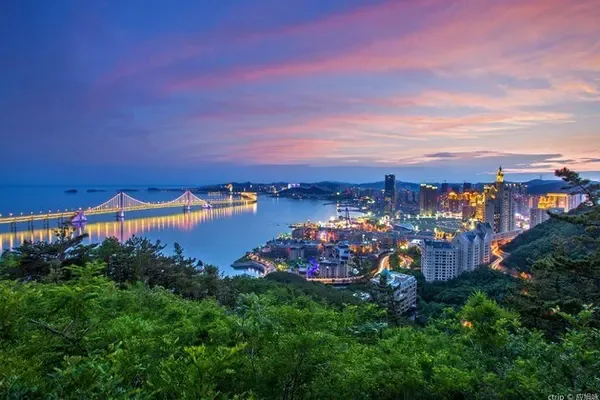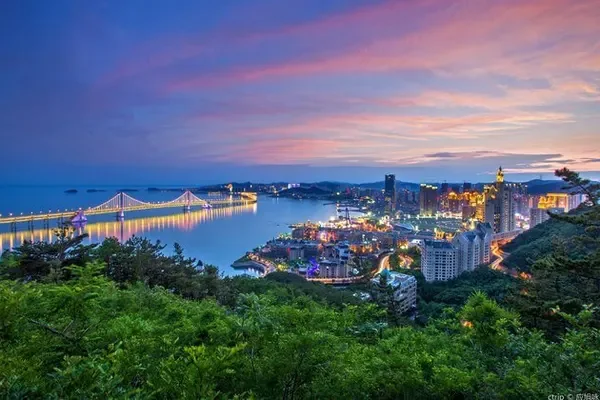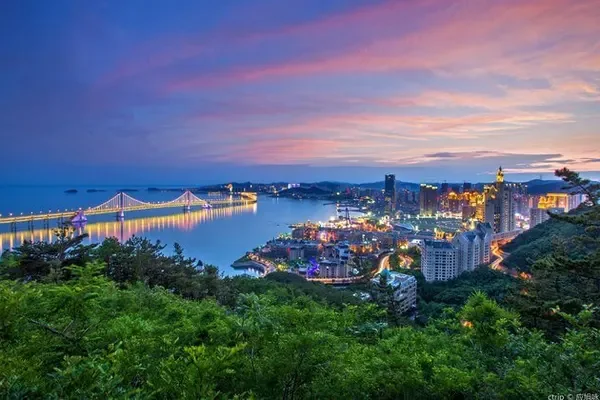I have walked the central axis more than once, but this is the first time I have walked the entire distance at one time, and it finally fulfilled one of my wishes.
On August 15th, my itinerary started from Yongdingmen.
Yongding Gate is the southernmost point of the central axis. In 2004, it was rebuilt according to the surveying and mapping data of the Republic of China period. The old city wall has been transformed into the second ring road, and there is a lot of traffic all day long. The reconstructed Yongding Gate can only straddle the second ring road. Following the trend of the central axis, the reconstruction of Yongdingmen is integrated with the construction of the city park. The park is strip-shaped and very open. Some people play tennis and children are roller skating. It is a leisure and fitness place for nearby residents. About 200 meters away from Yongdingmen, there are two relics of the royal road. When I went there before, they were covered with glass for protection. This time, I found that the glass has been removed. Visitors can directly touch the road hundreds of years ago and get in touch with history. .





Going north along the central axis from Yongdingmen, you will see the Temple of Heaven on the left and Xiannongtan on the right (now part is the Ancient Architecture Museum and part is Beijing Yucai School). Further forward is the flyover where folk artists such as storytellers, opera performers, and foreign film performers gather at the bottom level. Now there are several statues of rap and jugglers standing on the Bell Tower Square, which are lifelike. The flagship store of Deyun Club also has a Nearby. In the Ming and Qing Dynasties, there was indeed a white marble bridge here, which spanned the river in the north-south direction. Every time the emperor went to the Temple of Heaven to worship the heavens, he had to pass this bridge, so it was called Tianqiao, and this area got its name. Later, due to the decline of the dynasty and the development of the city, the river under the bridge became narrower and narrower, gradually evolved into a Longxugou, and finally turned into an underground river, and the bridge was completely demolished. In 2013, in order to restore the landscape of the central axis, the Beijing Municipal Government rebuilt the overpass. However, due to the huge changes in the road layout, in order not to affect the traffic, the newly built overpass was moved southward by about 40 meters on the basis of the original site. It is said that it was built on the original site There is a sign, but I have been there several times, but I can't find it. There is a passage under the bridge. The walls on both sides of the passage introduce the main bridge on the central axis and the components on the bridge in the form of pictures. It is worth seeing.


From the overpass to the front door, the two sides of the road are relatively dilapidated and have been in a state of renovation. The bare land on the roadside is covered with green dust-proof nets, and there are fences erected on the side of the street. Behind the fence is the old alley civilian area. Years, slow progress. So this section can be skipped directly by bicycle.
Qianmen Street is now a bustling commercial street, and tourists from all over Beijing will visit here. "Qianmen building is nine feet nine, four gates, three bridges and five archways", "Qianmen building is nine feet nine, nine alleys and nine willows", "Qianmen building is nine feet nine, and the big fence is facing Xianyukou", through From the jingles handed down from ancient times, you can still imagine what the street looked like at that time. In addition to Chinese and foreign modern brands, Qianmen also retains some traditional time-honored brands, such as Quanjude Roast Duck Restaurant, Duyi Shaomai Restaurant, Qianxiangyi Silk and Satin Shop, Yilong Mutton Restaurant, Zhang Yiyuan Tea House, Dabei Photo Studio, etc. The longer the brand is passed on, the more stories there will be, so behind every time-honored brand there is a legend that is closely connected with the fate of the country and the changes of the times. Xianyukou is a gourmet street. There is a Bianyifang Roast Duck restaurant with a history longer than Quanjude, so I don’t want to try it. It is said that there is a restaurant whose fried liver is the best in Beijing. There is no "one of them" ", when I have time, I must look for it. There is a bookstore called Page One at the front door, which is also unique. On its second and third floors, there are two large French windows facing south, directly facing Zhengyangmen, which is worth a visit just because of this.


The Zhengyangmen Archery Tower and Zhengyangmen Gate Tower on the south side of Qianmen Street stand on both sides of the bustling road. People who pass through it every day are familiar with it, and with the popularity of mobile phones, they have no time to take care of it. But if you know that he has stood there for two or three hundred years, and he has witnessed the historical changes of Beijing for hundreds of years, would you still dismiss him? At least I won't.


Across the wide Tiananmen Square is the Forbidden City. It basically takes a day to visit the Forbidden City, so I chose to walk along Nanchizi Street on the east side of the Forbidden City. Nanchizi Avenue and Nanchang Street are two symmetrical streets on both sides of the Forbidden City. They are completely different from the hustle and bustle of Chang'an Avenue. This time, I accidentally discovered "Huang Shicheng". I heard about Huangshiyan from Professor Yan Chongnian's "Six Hundred Years of the Forbidden City" series of lectures. It is mainly a place to preserve the emperor's family tree. The size is 90 centimeters by 50 centimeters. Professor Yan said that once he went to visit the jade document, it was carried out by two people. I have never seen such a big book. I heard that Huangshicheng has been opened to the outside world, and it can be arranged on the future schedule.




Jingshan Park in the north of the Forbidden City is a place I especially recommend. The park is not too big, and a ticket of two yuan is basically free for the Royal Garden. One of the most distinctive scenic spots in the park is the Wanchun Pavilion on the top of Jingshan Mountain, not only because it is the best place to look in all directions and overlook the city of Beijing (I was shocked when I overlooked the Forbidden City from this position for the first time), but also It is also the intersection of the east-west and north-south central points of the inner city of Beijing. Not far from Wanchun Pavilion is the martyrdom place of Emperor Chongzhen. The time when Emperor Chongzhen was martyred was 1644, and 300 years later, in 1944, Japan invaded China on a large scale, and China was once again on the verge of subjugation just like in 1644. The patriots at that time erected monuments here, one is "Ming Sizong's martyrdom", and the other is "Ming Sizong's martyrdom monument for 300 years", which is quite patriotic. In recent years, Beijing’s central axis has been applying for World Heritage Sites, so many scenic spots that have not been opened before have been restored. Huangshicheng is one of them, and the Shouhuang Palace on the north side of Jingshan is also one of them. After ten years of restoration, today’s The Shouhuang Palace is resplendent and resplendent. Seeing is believing, and it can also be arranged in the future schedule.


After leaving Jingshan, you can go north to taste old Beijing snacks at the Huguosi store at the intersection of Di'anmen. It can be considered a challenge.
About 200 meters further to the north is Wanning Bridge. Wanning Bridge is located on Di'anmen Inner Street. It still undertakes modern traffic functions, and countless pedestrians and vehicles pass by every day. Although it doesn't seem to be very famous, you must not underestimate him. The lions on the column caps and the water town beast under the bridge are originals from the Ming Dynasty, and there are even two small beasts from the Yuan Dynasty lying under the water. , are over several hundred years old.

The northernmost end of the central axis is the Drum Tower and the Bell Tower. The Drum Tower and Bell Tower are places for telling time in ancient times. There are usually some exhibitions about ancient timing methods and timing tools, and sometimes there are performances of beating drums. The square between the Bell and Drum Towers is a leisure place for nearby residents, sheltered from the wind and exposed to the sun, and the sun in winter is extraordinarily warm. I once read a novel written by Liu Xinwu called "The Bell and Drum Tower", which tells the story of the Bell and Drum Tower in Beijing in the early 1980s. The whole book describes the stories of all social classes through the stories that happened within 12 hours. The life scenes show the life and social changes in Beijing in the 1980s.


From Yongdingmen to Bell and Drum Tower, the central axis is 7.8 kilometers long. Maybe you can’t see this line, but when you think in your heart that this is a famous and only line in the world, this line runs through the brilliant masterpieces of ancient Chinese architecture, embodies the philosophy of Chinese culture, and carries the Chinese culture. The historical accumulation of civilization, when you think of these in your heart, walking is different.
Today, the central axis of "New Beijing" has been extending from the Gulouwai Street to the north, leading directly to the world-famous Olympic Forest Park. The Bird's Nest and the Water Cube are located on the east and west sides, which coincides with the concept of a round sky, and finally ends in the Olympic Forest Park. The main peak is Yangshan. The newly opened central axis is called Beichen Road, which should be derived from the Analects of Confucius "Government with virtue, such as Beichen, where the stars live and the stars support it".


